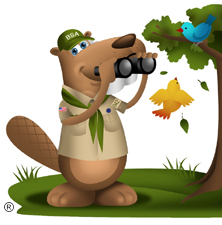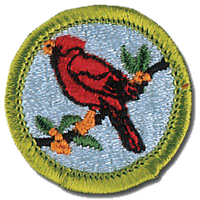Bird Study


Resources
- Bird Study Merit Badge Pamphlet
- Bird Study Merit Badge Class Preparation Page
- Bird Study Merit Badge Workbook
- Scoutmaster Bucky Bird Study Field Notebook
- Scoutmaster Bucky's Merit Badge Advancement Quick Reference
- Scoutmaster Bucky's Acknowledgement Form
Related
Bird Study Requirements
Current Scouts BSA requirements
as of December 6, 2025
as of December 6, 2025
1.
Explain the need for bird study and why birds are useful indicators of the
quality of the environment. Describe how birds are part of the ecosystem.
2.
Show that you are familiar with the terms used to describe birds by doing
the following:
a.
Sketch or trace a perched bird and then label 15 different parts of the
bird.
b.
Sketch or trace an extended wing and label six types of wing feathers.
3.
Demonstrate that you know how to properly use and care for binoculars, a
spotting scope, or a monocular.
a.
Explain what the specification numbers mean on binoculars, a spotting
scope, or a monocular.
b.
Show how to adjust the eyepiece and how to focus for proper viewing.
c.
Show how to properly care for and clean the lenses.
d.
Describe when and where each type of viewing device would be most
effective.
4.
Demonstrate that you know how to use a bird field guide. Show your
counselor that you are able to understand a range map by locating in the
book and pointing out:
a.
Seabird
b.
Plover
c.
Falcon or hawk
d.
Warbler or vireo
e.
Heron or egret
f.
Sparrow.
5.
Observe and be able to identify 20 species of wild birds. Prepare a field
notebook, making a separate entry for each species, and record the
following information from your field observations and other references.
a.
Note the date and time.
b.
Note the location and habitat.
c.
Describe the bird's main feeding habitat and list two types of food
that the bird is likely to eat.
d.
Note whether the bird is a migrant or a summer, winter, or year-round
resident of your area.
6.
Describe to your counselor how certain orders of birds are uniquely adapted
to a specific habitat. In your description, include characteristics such as
the size and shape of the following:
a.
Beak
b.
Body
c.
Leg and foot
d.
Feathers/plumage.
7.
Explain the function of a bird's song. Be able to identify five of the 20
species in your field notebook by song or call alone. Explain the
difference between songs and calls. For each of these five species, enter a
description of the song or call, and note the behavior of the bird making
the sound. Note why you think the bird was making the call or song that you
heard.
8.
Do ONE of the following:
a.
Go on a field trip with a local club or with others who are
knowledgeable about birds in your area.
1.
Keep a list or fill out a checklist of all the birds your group
observed during the field trip.
2.
Tell your counselor which birds your group saw and why some species
were common and some were present in small numbers.
3.
Tell your counselor what makes the area you visited good for
finding birds.
b.
By using a public library, the internet, or contacting the National
Audubon Society, find the name and location of the Christmas Bird Count
nearest your home and obtain the results of a recent count.
1.
Explain what kinds of information are collected during the annual
event.
2.
Tell your counselor which species are most common, and explain why
these birds are abundant.
3.
Tell your counselor which species are uncommon, and explain why
these were present in small numbers. If the number of birds of
these species is decreasing, explain why, and what, if anything,
could be done to reverse their decline.
c.
Participate in a bird banding program with an approved federal or state
agency, university researcher, bird observatory, or certified private
individual.
1.
Explain who is able to band birds and why.
2.
Explain why birds get banded.
3.
Explain what kinds of birds get banded.
4.
Tell how the birds were captured, the number of bird species
recorded during your visit, and your role in the program.
9.
Do ONE of the following. For the option you choose, describe what birds you
hope to attract, and why.
a.
Build a bird feeder and put it in an appropriate place in your yard
or another location.
b.
Build a birdbath and put it in an appropriate place.
c.
Build a backyard sanctuary for birds by planting trees and shrubs for
food and cover.
d.
Build a nest box for a species of your choice using plans approved by
your counselor.
10.
Do the following:
a.
Explain the differences between extinct, endangered, and threatened.
b.
Identify a bird species that is on the endangered or threatened list.
Explain what caused their decline. Discuss with your counselor what can
be done to reverse this trend and what can be done to help remove the
species from the endangered or threatened list.
11.
Identify a non-native bird (introduced to North America from a foreign
country since 1800). Describe how non-native birds may become damaging to
the ecosystem.
12.
Identify three career opportunities connected to the study of birds. Pick
one and find out the education, training, and experience required for this
profession. Discuss with your counselor if this profession might interest
you.